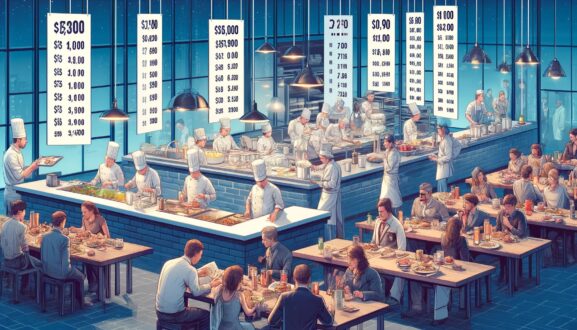Restaurant CoGS: Mastering the Backbone of Restaurant Profitability
Welcome to the bustling world of restaurant management, where understanding your Cost of Goods Sold (CoGS) is as crucial as nailing that secret recipe. Restaurant CoGS isn’t just a dry financial metric; it’s the lifeblood of your restaurant’s economic engine and one of the most important restaurant KPIs to keep an eye on.
This figure represents the direct costs tied to producing the dishes and drinks that grace your menu—from the ripest tomatoes and freshest seafood to the beans for your morning brews.
Why should you care? Because mastering your COGS is the first step to gastronomic glory and financial success. It affects everything from pricing strategies to profitability.
In the dynamic world of food service, where ingredient costs can swing wildly with the seasons, keeping a tight ship on COGS is your ticket to navigating through stormy financial waters with confidence.
How to Calculate Restaurant COGS: A Closer Look
Think of calculating COGS as your financial mise en place. It’s preparing you to cook the books (in a good way, of course).
You start with your beginning inventory, add any purchases made during the period, and subtract your ending inventory. This formula isn’t just math; it’s a strategic tool.
Here’s a real-world application: Imagine you run a cozy café.
At the start of April, you had $5,000 worth of coffee beans, syrups, and pastries in stock. Throughout April, you purchased an additional $2,000 worth of supplies.
By the end of the month, you had $1,000 worth left. Your COGS for April?
A tidy sum of $6,000.
But here’s the kicker—understanding seasonal variations can significantly affect your COGS. A spike in dairy prices can turn your cappuccino’s cost upside down.
Regularly revisiting your COGS helps you adjust pricing or find cost-effective substitutes, ensuring your margins remain healthy even when the market does somersaults.
Prime Costs: The Full Picture
While COGS gives you a glimpse, prime costs throw open the financial curtains. By adding labor expenses to COGS, you get a panoramic view of your operational costs.
This is where you see how your chefs, servers, and dishwashers contribute to your financial narrative.
Managing prime costs is about finding balance.
Suppose your prime costs overshoot 60% of your sales. It’s a red flag that you’re either overspending on ingredients or labor, or your menu prices need an overhaul.
Striking the right balance means optimizing both your kitchen efficiency and your team’s productivity, ensuring that every dollar spent turns into satisfied customers and healthy profits.
The Profit Margin Balancing Act
Navigating restaurant profit margins is akin to tightrope walking. With average net margins dancing between 2-6%, every decision counts.
The “Big Three”—COGS, labor, and overhead—are the winds that sway your financial tightrope. Understanding how these factors interplay is crucial for stability.
Let’s break it down.
Optimizing menu pricing isn’t just about covering costs; it’s about creating value for both you and your customers.
Controlling inventory goes beyond avoiding spoilage; it’s about maximizing the use of every ingredient.
Minimizing waste isn’t just an operational goal; it’s a financial strategy.
Strategies for Reducing COGS: Beyond the Basics
Reducing COGS is your strategic move towards greater profitability. It involves being savvy with your purchases—like buying in bulk and negotiating with suppliers.
But there’s more. For example, consider using seasonal ingredients not only for their cost-effectiveness but also for adding flair to your menu. Also, regularly revisiting your menu to phase out low-margin items can make a significant difference.
9 ways to lower your restaurant CoGS:
Alright, let’s delve into detailed strategies for reducing the Cost of Goods Sold (COGS) in restaurants, drawing inspiration to elaborate on tactics similar to those discussed in various resources, like the one you mentioned. By implementing these strategies, restaurants can better manage their direct costs, enhance profitability, and ensure long-term success.
1. Streamline Your Menu
Reducing the complexity of your menu can lead to significant savings in COGS. A streamlined menu requires fewer ingredients, which not only reduces waste but also allows for bulk purchasing at discounted rates. Focus on dishes that share common ingredients yet still appeal to a broad customer base. This approach simplifies inventory management and reduces the risk of spoilage.
2. Optimize Portion Control
Portion control is crucial for managing food costs effectively. Standardizing portion sizes ensures consistent customer experiences while keeping ingredient use in check. Use precise measuring tools and train your staff to adhere to these standards. This reduces overuse of ingredients per dish, directly impacting your COGS.
3. Leverage Seasonal Ingredients
Incorporating seasonal ingredients into your menu can drastically reduce costs. Seasonal produce is typically cheaper, fresher, and of higher quality. Moreover, it adds variety to your menu, attracting customers interested in trying new, seasonal dishes. This strategy requires flexibility in menu planning but can lead to substantial savings and a unique dining experience.
4. Negotiate with Suppliers
Never settle on the first price offered by suppliers. The cost of goods can often be negotiated, especially if you establish long-term relationships or agree to bulk purchases. Regularly review your suppliers and don’t hesitate to shop around to ensure you’re getting the best prices without compromising quality.
5. Reduce Waste
Waste reduction is a direct path to lowering COGS. Implementing a comprehensive waste management strategy that includes regular audits of waste, training staff on waste reduction practices, and utilizing inventory more efficiently can lead to significant cost savings. Explore creative ways to use leftovers or excess inventory, such as incorporating them into daily specials.
6. Implement Inventory Management Software
Technology can be a game-changer in managing COGS. Inventory management software helps track ingredient usage, monitor stock levels, and predict ordering needs with greater accuracy. This reduces the risk of overordering or spoilage, both of which can inflate COGS unnecessarily.
7. Focus on Energy Efficiency
While not directly related to ingredient costs, energy efficiency in your kitchen can lead to lower operational costs, allowing more room to manage COGS effectively. Energy-efficient appliances, proper maintenance of equipment, and training staff to use resources more efficiently can reduce utility bills significantly.
8. Engage in Group Purchasing Organizations (GPOs)
Joining a GPO can offer significant savings on ingredients through bulk purchasing agreements negotiated on behalf of the group. This collective bargaining power allows small and medium-sized restaurants to access discounts typically reserved for larger chains.
9. Continuously Train Your Staff
Educating your staff on the importance of COGS and how their actions affect it is vital. Regular training sessions on portion control, waste reduction, and efficient use of ingredients can cultivate a cost-saving culture within your team.
Implementing these strategies requires a holistic approach to managing your restaurant. It’s not just about cutting costs but optimizing operations, enhancing the dining experience, and maintaining quality. By focusing on efficient practices, from procurement to plate, restaurants can significantly reduce their COGS, improve profitability, and ensure a sustainable business model.
Each of these strategies can be tailored to fit the specific needs and circumstances of your restaurant. The key is continuous evaluation and adjustment to maintain a balance between quality, customer satisfaction, and cost efficiency. With careful planning and execution, these tactics can lead to a more profitable and sustainable restaurant operation.
Restaurant CoGS Case Study
The transformation of Restaurant One in Orange County, New York, into a more profitable operation, as facilitated by Lopolito Hospitality Consultants, offers a comprehensive example of how targeted interventions can significantly uplift a restaurant’s service quality and financial outcomes.
Assignment Overview:
Restaurant One sought expertise to enhance its profitability and Front-of-House (FOH) services amidst a competitive local dining scene.
The restaurant’s offerings spanned casual and sports bar dining, including a separate banquet room, operating across all seven days for lunch and dinner.
Introduction & Initial Observations:
The initial assessment revealed core operational inefficiencies, impacting both service quality and profitability.
Immediate concerns included poor customer greeting practices, unsatisfactory service standards, and frequent errors in food and beverage orders.
These issues were symptomatic of broader management and operational challenges, including improper inventory management, unstandardized alcohol pouring practices, and insufficient staff training and management.
Management Interventions & Training:
To address these challenges, Lopolito Hospitality Consultants undertook several strategic steps:
– Position Descriptions and Training Guides: Development of detailed job descriptions and training materials for various staff roles to standardize operations.
– Managerial Training: Coaching the general manager on crucial skills like inventory management, understanding COGS, and menu engineering.
– Inventory Management: Introduction of inventory spreadsheets, training on First In, First Out (FIFO) principles, and accurate calculation of alcohol pouring cost percentages.
– Staff Training Programs: Implementation of comprehensive training programs, particularly focusing on alcohol pour training to tackle inconsistencies and cost issues.
Outcomes:
These interventions led to significant improvements in operational efficiencies and cost management, notably:
– Reduced Pouring Costs: Marked decrease in pouring cost percentages for wine, beer, and alcohol, contributing to improved COGS management.
– Enhanced Profitability: An average increase in monthly profitability, with a projected annual profit boost, underscoring the effectiveness of the implemented strategies.
Conclusion:
The case study underscores the importance of meticulous operational and financial management in the hospitality industry.
Through targeted training, improved inventory management, and operational standardization, Restaurant One was able to enhance its service quality and achieve a notable increase in profitability.
This transformation exemplifies how addressing foundational operational inefficiencies can lead to significant financial gains and improved customer satisfaction.
Conclusion and Best Practices
Mastering COGS and prime costs isn’t just about keeping your restaurant afloat; it’s about setting it up for sustainable success.
Regular monitoring, a keen eye on the market, efficient inventory management, and a strategic approach to pricing and menu design are your tools for this journey.
By adhering to these principles, you’re not just running a restaurant; you’re cultivating a thriving business that delights the palate as much as it does the bottom line.
The world of restaurant management is complex, but with the right financial strategies in place, it’s a world ripe with opportunities for success.


